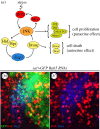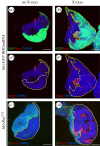Pro-apoptotic and pro-proliferation functions of the JNK pathway of Drosophila: roles in cell competition, tumorigenesis and regeneration
- PMID: 30836847
- PMCID: PMC6451367
- DOI: 10.1098/rsob.180256
Pro-apoptotic and pro-proliferation functions of the JNK pathway of Drosophila: roles in cell competition, tumorigenesis and regeneration
Abstract
The Jun N-terminal kinase (JNK) is a member of the mitogen-activated protein kinase family. It appears to be conserved in all animal species where it regulates important physiological functions involved in apoptosis, cell migration, cell proliferation and regeneration. In this review, we focus on the functions of JNK in Drosophila imaginal discs, where it has been reported that it can induce both cell death and cell proliferation. We discuss this apparent paradox in the light of recent findings and propose that the pro-apoptotic and the pro-proliferative functions are intrinsic properties of JNK activity. Whether one function or another is predominant depends on the cellular context.
Keywords: Jun N-terminal kinase; apoptosis; cell competition; regeneration; tumorigenesis.
Conflict of interest statement
We declare we have no competing interests.
Figures





Similar articles
-
Regenerative response of different regions of Drosophila imaginal discs.Int J Dev Biol. 2018;62(6-7-8):507-512. doi: 10.1387/ijdb.170326gm. Int J Dev Biol. 2018. PMID: 29938762 Review.
-
Role of D-GADD45 in JNK-Dependent Apoptosis and Regeneration in Drosophila.Genes (Basel). 2019 May 18;10(5):378. doi: 10.3390/genes10050378. Genes (Basel). 2019. PMID: 31109086 Free PMC article.
-
Necrosis-induced apoptosis promotes regeneration in Drosophila wing imaginal discs.Genetics. 2021 Nov 5;219(3):iyab144. doi: 10.1093/genetics/iyab144. Genetics. 2021. PMID: 34740246 Free PMC article.
-
Loss of putzig Activity Results in Apoptosis during Wing Imaginal Development in Drosophila.PLoS One. 2015 Apr 20;10(4):e0124652. doi: 10.1371/journal.pone.0124652. eCollection 2015. PLoS One. 2015. PMID: 25894556 Free PMC article.
-
JNK Signaling in Drosophila Aging and Longevity.Int J Mol Sci. 2021 Sep 6;22(17):9649. doi: 10.3390/ijms22179649. Int J Mol Sci. 2021. PMID: 34502551 Free PMC article. Review.
Cited by
-
Bilateral JNK activation is a hallmark of interface surveillance and promotes elimination of aberrant cells.Elife. 2023 Feb 6;12:e80809. doi: 10.7554/eLife.80809. Elife. 2023. PMID: 36744859 Free PMC article.
-
A novel injury paradigm in the central nervous system of adult Drosophila: molecular, cellular and functional aspects.Dis Model Mech. 2021 May 1;14(5):dmm044669. doi: 10.1242/dmm.044669. Epub 2021 Jun 1. Dis Model Mech. 2021. PMID: 34061177 Free PMC article.
-
Infection of Galleria mellonella (Lepidoptera) Larvae With the Entomopathogenic Fungus Conidiobolus coronatus (Entomophthorales) Induces Apoptosis of Hemocytes and Affects the Concentration of Eicosanoids in the Hemolymph.Front Physiol. 2022 Jan 6;12:774086. doi: 10.3389/fphys.2021.774086. eCollection 2021. Front Physiol. 2022. PMID: 35069239 Free PMC article.
-
Mutual repression between JNK/AP-1 and JAK/STAT stratifies senescent and proliferative cell behaviors during tissue regeneration.PLoS Biol. 2023 May 30;21(5):e3001665. doi: 10.1371/journal.pbio.3001665. eCollection 2023 May. PLoS Biol. 2023. PMID: 37252939 Free PMC article.
-
Identification of the Wallenda JNKKK as an Alk suppressor reveals increased competitiveness of Alk-expressing cells.Sci Rep. 2020 Sep 11;10(1):14954. doi: 10.1038/s41598-020-70890-6. Sci Rep. 2020. PMID: 32917927 Free PMC article.
References
Publication types
MeSH terms
Substances
LinkOut - more resources
Full Text Sources
Molecular Biology Databases
Research Materials
Miscellaneous

